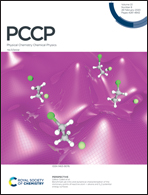Potential molecular semiconductor devices: cyclo-Cn (n = 10 and 14) with higher stabilities and aromaticities than acknowledged cyclo-C18†
Abstract
The successful synthesis and isolation of cyclo-C18 in experiments is a ground-breaking development in carbon rings. Herein, we studied the thermodynamic stabilities of cyclo-Cn (4 ≤ n ≤ 34) with hybrid density functional theory. When n = 4N + 2 (N is an integer), cyclo-Cn were thermodynamically stable. In particular, cyclo-C10 and cyclo-C14 were more thermodynamically, kinetically, dynamically, and optically stable compared with the acknowledged cyclo-C18, and were potential candidates for zero-dimensional carbon rings. Cyclo-Cn (n = 10 and 14) show similar molecular semiconductor characteristics to the acknowledged cyclo-C18. The carbon atoms were sp hybridized in cyclo-C10, cyclo-C14, and cyclo-C18. Cyclo-C14 and cyclo-C18 had alternating abnormal single and triple bonds, but cyclo-C10 had equal bonds. Cyclo-C10, cyclo-C14, and cyclo-C18 with large aromaticities had out-of-plane and in-plane π systems, which were perpendicular to each other. The number of π electrons in the out-of-plane and in-plane π systems, respectively, followed the standard Hückel aromaticity rule. Simulated UV-vis-NIR spectra indicated similar electronic structures of cyclo-C14 and cyclo-C18.



 Please wait while we load your content...
Please wait while we load your content...